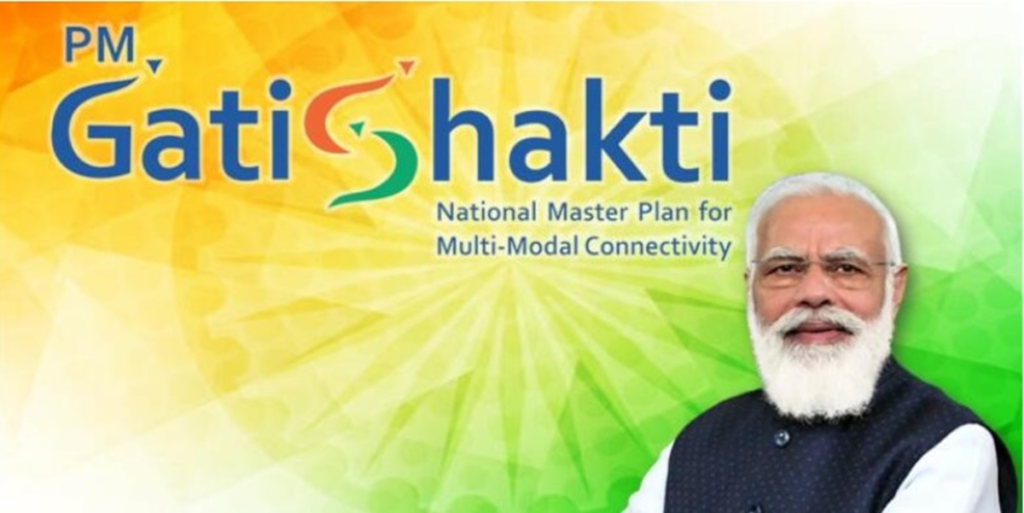PM GatiShakti National Master Plan (Prelims- Polity & Governance)
Why in News?
The PM GatiShakti National Master Plan (NMP) for multimodal connectivity, launched by Prime Minister Narendra Modi, has completed three years of achieving significant milestones in transforming the country’s infrastructure landscape.

About PM GatiShakti National Master Plan
This digital platform is designed to bring various Ministries, including Railways and Roadways, to ensure integrated planning and coordinated execution of infrastructure projects.NMP has onboarded 44 Central Ministries and 36 States/UTs,
The initiative aims to provide seamless and efficient connectivity for the movement of people, goods, and services across various modes of transport, thereby enhancing last-mile connectivity and reducing travel time. This will boost economic growth, attract foreign investments and enhance the country’s global competitiveness.
PM Gati Shakti incorporates the infrastructure schemes of various Ministries and State Governments such as Bharatmala, Sagarmala, inland waterways, dry/land ports, and UDAN.
Vision of PM Gati Shakti
PM Gati Shakti will incorporate the infrastructure schemes of various Ministries and State Governments like Bharatmala, Sagarmala, inland waterways, dry/land ports, UDAN etc. Economic Zones like textile clusters, pharmaceutical clusters, defence corridors, electronic parks, industrial corridors, fishing clusters, agri zones will be covered to improve connectivity & make Indian businesses more competitive.
It will also leverage technology extensively including spatial planning tools with ISRO (Indian Space Research Organisation) imagery developed by BiSAG-N (Bhaskaracharya National Institute for Space Applications and Geoinformatics).
Why Gati Shakti?
Traditionally, there was lack of coordination between different Departments, for example, once a road was constructed, other agencies dug up the constructed road again for activities like laying of underground cables, gas pipelines etc. This not only caused great inconvenience but was also a wasteful expenditure.
To address this, efforts were made to increase coordination so that all cables, pipelines etc. could be laid simultaneously. Steps have also been taken to address other issues like time-taking approval process, multiplicity of regulatory clearances etc. In the last few years, the Government has ensured unprecedented focus on infrastructure through a holistic outlook. This helps to address past issues by institutionalising holistic planning for stakeholders for major infrastructure projects. Instead of planning & designing separately in silos, the projects will be designed and executed with a common vision.
The scheme is driven by 7 engines: roads, airports, mass transport, logistics infrastructure, railways, ports and waterways.

Digital Platform: The Digital Master Planning tool has been prepared in a dynamic Geographic Information System (GIS) platform wherein data on specific action plan of all the Ministries/Departments have been incorporated within a comprehensive database. It will use satellite imagery available from ISRO and base maps from Survey of India.
Three years of PM GatiShakti National Master Plan (NMP)
The PM GatiShakti NMP has resulted in numerous achievements across various sectors, significantly improving project planning, speed, and execution.
Key Achievements
On boarding Whole of the Government on the Single platformPM GatiShakti has integrated 44 Central Ministries and 36 States/UTs with more than 1600 data layers, making it a crucial tool for planning and executing infrastructure projects. To date, over 200 big-ticket infrastructure projects have been evaluated by the Networking Planning Group (NPG) from the perspective of the principles of the PM GatiShakti.
Social Sector Impact: Extending the PM GatiShakti to the Social Sector Ministries, has enabled better infrastructure planning in essential areas such as primary healthcare, education, postal services, and tribal development, ensuring that even remote and underserved areas are part of India’s infrastructure growth story.
PM GatiShakti State Master Plans (SMPs): All 36 States/UTs have developed the PM GatiShakti State Master Plan (SMP) portals, aligned with the PM GatiShakti National Master Plan . Over 533 projects have been mapped by States/UTs on the PM GatiShakti portal.
EXIM and Trade Facilitation: Aligned with the National Logistics Policy (NLP), the PM GatiShakti has been instrumental in addressing critical infrastructure gaps, reducing logistics costs, and improving India’s logistics performance. According to the World Bank’s ‘Logistics Performance Index Report (2023) India’s rank (38) has improved by six places from 44 in 2018.
Regional Workshops and Stakeholder Engagement: These engagements have played a key role in strengthening local adoption and ownership of the GatiShakti framework.
Driving Sustainable, Data-Driven Development: The platform ensures that projects are aligned with national priorities and completed on time, minimising delays and reducing cost overruns. This integration is key to meeting India’s Net Zero by 2070 commitments, as the platform promotes the use of green infrastructure and sustainable logistics solutions.
Training and Capacity Building: The PM GatiShakti National Master Plan (PMGS NMP) has seen significant progress in capacity building through the institution of courses and workshops.
Extending PMGS to the Districts: PM GatiShakti District Master Plan (PMGS DMP) portal is being developed for collaborative planning at the District level by State/District authorities.
The NMP platform’s emphasis on cross-sectoral cooperation and emerging technologies such as AI and IoT will further revolutionise infrastructure management and planning.
As India celebrates three years of the PM Gati Shakti, the initiative continues to fulfil its promise of creating a modern, interconnected infrastructure network that is key to India’s Atmanirbhar Bharat vision.


